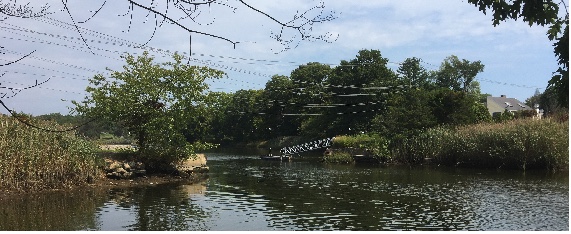Committee Previously Received Bulk of Monies for Bridge Design From Old Lyme’s ARPA Funds

OLD LYME — On Monday, Connecticut Governor Ned Lamont and Energy and Environmental Protection Commissioner Katie Dykes announced that approximately $9 million in state grants is being released through the Connecticut Recreational Trails Program to plan, build, expand, and improve a total of 50 multi-use trails across Connecticut.
One of the projects selected for funding relates to design work for the Lieutenant River Bridge and Trails project in Old Lyme.
The Halls Road Improvements Committee (HRIC) submitted an application for $28,500, which represented the remaining funds required for the project. This amount was determined after the bulk of the design costs for AI Engineering’s work was covered by an allocation of $135,000 made last summer by Old Lyme’s American Rescue Plan Act (ARPA) Committee.
The HRIC said in a press release dated May 17, that it is, “… pleased to announce that we have been awarded the full asking amount of $28,500 from the CT Recreational Trails Grant.”
The announcement continues, “The two grants will result in a technical plan for a public-use bridge that will connect the commercial center of Old Lyme with its Arts and Historic Districts.”
The HRIC concludes, “Once the conceptual plan is approved by the town with community input, the final engineered design will be the basis for future grants applications to cover the costs of constructing the multi-use bridge and trails along Halls Road.”
The Connecticut Recreational Trails Program is administered by the Connecticut Department of Energy and Environmental Protection (DEEP). Funding for this grant round was allocated by the State Bond Commission in July 2022. Governor Lamont serves as chairman of the commission.
Governor Lamont said, “I am thrilled to announce funding for these 50 projects, which will improve and expand recreational trail opportunities around Connecticut. The incredible response to this grant round shows the high demand for outdoor recreation in our state. Our residents and visitors continue to explore state parks, forests, and municipal open spaces and land trust preserves at record levels.”
DEEP has seen demand for outdoor recreation increase dramatically since the onset of the COVID-19 pandemic in early 2020. Annual visits to locations in the Connecticut State Parks and Forests system reached an estimated 17 million in 2022 – a 75 percent increase from pre-pandemic visitation levels of between 9 and 10 million in 2019.
Additionally, the economic value of hiking, climbing, and tent camping increased by 50 percent from 2019 to 2021. According to the Bureau of Economic Analysis, the value of outdoor recreation in 2021 contributed nearly $4 billion to the state and supported more than 40,000 jobs.
“These projects are timely and will improve our state’s connectivity and accessibility to open space, which benefits our residents and visitors physically and mentally, enhances our state’s outdoor economy, and makes our state such an attractive place to live,” Commissioner Dykes said.
She continued, “Investing in projects that support sustainable commuting opportunities, that reduce pollution from transportation, and provide safe, enjoyable alternatives to car travel are the type of projects we’d love to see in more communities across the state.”
The Connecticut Greenways Council assisted DEEP with the competitive grant selection process. Funding for program administration of 5 percent, pursuant to state statutes, is also included in the grants.
DEEP anticipates most of the awarded projects being completed by 2026.
Editor’s Notes: i) This article is based on press releases from respectively Old Lyme’s Halls Road Improvements Committee and the Connecticut Department of Energy and Environmental Protection.
ii) Visit this link for more information on the Connecticut Recreational Trails Program.